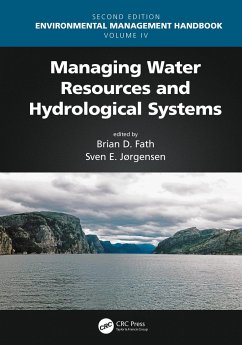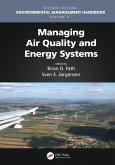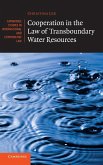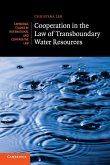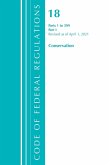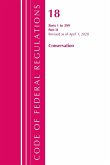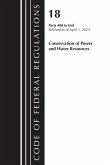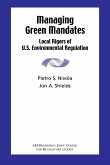Managing Water Resources and Hydrological Systems
Herausgeber: Fath, Brian D.; Jorgensen, Sven Erik
Managing Water Resources and Hydrological Systems
Herausgeber: Fath, Brian D.; Jorgensen, Sven Erik
- Gebundenes Buch
- Merkliste
- Auf die Merkliste
- Bewerten Bewerten
- Teilen
- Produkt teilen
- Produkterinnerung
- Produkterinnerung
This book introduces the general concepts and processes of hydrosphere and its systems. It explains how these systems function and provides strategies on how to best manage them. It serves as an excellent resource for finding basic knowledge on the hydrosphere and includes important problems that environmental managers face today.
Andere Kunden interessierten sich auch für
![Managing Air Quality and Energy Systems Managing Air Quality and Energy Systems]() Managing Air Quality and Energy Systems91,99 €
Managing Air Quality and Energy Systems91,99 €![Cooperation in the Law of Transboundary Water Resources Cooperation in the Law of Transboundary Water Resources]() Christina LebCooperation in the Law of Transboundary Water Resources114,99 €
Christina LebCooperation in the Law of Transboundary Water Resources114,99 €![Cooperation in the Law of Transboundary Water Resources Cooperation in the Law of Transboundary Water Resources]() Christina LebCooperation in the Law of Transboundary Water Resources45,99 €
Christina LebCooperation in the Law of Transboundary Water Resources45,99 €![Code of Federal Regulations, Title 18 Conservation of Power and Water Resources 1-399, Revised as of April 1, 2021 Code of Federal Regulations, Title 18 Conservation of Power and Water Resources 1-399, Revised as of April 1, 2021]() Office Of The Federal Register (U. S.Code of Federal Regulations, Title 18 Conservation of Power and Water Resources 1-399, Revised as of April 1, 202134,99 €
Office Of The Federal Register (U. S.Code of Federal Regulations, Title 18 Conservation of Power and Water Resources 1-399, Revised as of April 1, 202134,99 €![Code of Federal Regulations, Title 18 Conservation of Power and Water Resources 1-399, Revised as of April 1, 2020 Code of Federal Regulations, Title 18 Conservation of Power and Water Resources 1-399, Revised as of April 1, 2020]() Office Of The Federal Register (U. S.Code of Federal Regulations, Title 18 Conservation of Power and Water Resources 1-399, Revised as of April 1, 202034,99 €
Office Of The Federal Register (U. S.Code of Federal Regulations, Title 18 Conservation of Power and Water Resources 1-399, Revised as of April 1, 202034,99 €![Code of Federal Regulations, Title 18 Conservation of Power and Water Resources 400-END, 2023 Code of Federal Regulations, Title 18 Conservation of Power and Water Resources 400-END, 2023]() Office Of The Federal Register (U. S.Code of Federal Regulations, Title 18 Conservation of Power and Water Resources 400-END, 202329,99 €
Office Of The Federal Register (U. S.Code of Federal Regulations, Title 18 Conservation of Power and Water Resources 400-END, 202329,99 €![Managing Green Mandates Managing Green Mandates]() Pietro S. NivolaManaging Green Mandates10,99 €
Pietro S. NivolaManaging Green Mandates10,99 €-
-
-
This book introduces the general concepts and processes of hydrosphere and its systems. It explains how these systems function and provides strategies on how to best manage them. It serves as an excellent resource for finding basic knowledge on the hydrosphere and includes important problems that environmental managers face today.
Hinweis: Dieser Artikel kann nur an eine deutsche Lieferadresse ausgeliefert werden.
Hinweis: Dieser Artikel kann nur an eine deutsche Lieferadresse ausgeliefert werden.
Produktdetails
- Produktdetails
- Verlag: CRC Press
- 2. Auflage
- Seitenzahl: 760
- Erscheinungstermin: 30. Juli 2020
- Englisch
- Abmessung: 260mm x 183mm x 45mm
- Gewicht: 1598g
- ISBN-13: 9781138342668
- ISBN-10: 1138342661
- Artikelnr.: 69944037
- Herstellerkennzeichnung
- Libri GmbH
- Europaallee 1
- 36244 Bad Hersfeld
- gpsr@libri.de
- Verlag: CRC Press
- 2. Auflage
- Seitenzahl: 760
- Erscheinungstermin: 30. Juli 2020
- Englisch
- Abmessung: 260mm x 183mm x 45mm
- Gewicht: 1598g
- ISBN-13: 9781138342668
- ISBN-10: 1138342661
- Artikelnr.: 69944037
- Herstellerkennzeichnung
- Libri GmbH
- Europaallee 1
- 36244 Bad Hersfeld
- gpsr@libri.de
Brian D. Fath is a Professor in the Department of Biological Sciences at Towson University (Maryland, USA) and a Senior Research Scholar at the International Institute for Applied Systems Analysis (Laxenburg, Austria). He has published over 180 research papers, reports, and book chapters on environmental systems modeling, specifically in the areas of network analysis, urban metabolism, and sustainability. He has co-authored the books A New Ecology: Systems Perspective (2020), Foundations for Sustainability: A Coherent Framework of Life-Environment Relations (2019), and Flourishing within Limits to Growth: Following Nature's Way (2015). He is also Editor-in-Chief for the journal Ecological Modelling and Co-Editor-in-Chief for Current Research in Environmental Sustainability. Dr. Fath was the 2016 recipient of the Prigogine Medal for outstanding work in systems ecology and twice a Fulbright Distinguished Chair (Parthenope University, Naples, Italy, in 2012 and Masaryk University, Czech Republic, in 2019). In addition, he has served as Secretary General of the International Society for Ecological Modelling, Co-Chair of the Ecosystem Dynamics Focus Research Group in the Community Surface Modeling Dynamics System, and member and past Chair of the Baltimore County Commission on Environmental Quality. Sven E. Jørgensen (1934-2016) was a Professor of Environmental Chemistry at Copenhagen University. He earned a doctorate of engineering in environmental technology and a doctorate of science in ecological modeling. He was an honorable doctor of science at Coimbra University (Portugal) and at Dar es Salaam (Tanzania). He was Editor-in-Chief of Ecological Modelling from the journal's inception in 1975 until 2009. He was Editor-in-Chief for the Encyclopedia of Environmental Management (2013) and Encyclopedia of Ecology (2008). In 2004, Dr. Jorgensen was awarded the Stockholm Water Prize and the Prigogine Medal. He was awarded the Einstein Professorship by the Chinese Academy of Sciences in 2005. In 2007, he received the Pascal Medal and was elected a member of the European Academy of Sciences. He published over 350 papers and has edited or written over 70 books. Dr. Jorgensen gave popular and well-received lectures and courses in ecological modeling, ecosystem theory, and ecological engineering worldwide.
Section I: APC: Anthropogenic Chemicals and Activities 1. Aquatic
Communities: Pesticide Impacts 2. Coastal Water: Pollution 3. Groundwater:
Mining Pollution 4. Groundwater: Nitrogen Fertilizer Contamination 5.
Groundwater: Pesticide Contamination 6. Lakes and Reservoirs: Pollution 7.
Mines: Acidic Drainage Water 8. Rivers and Lakes: Acidification 9. Rivers:
Pollution 10. Sea: Pollution Section II: COV: Comparative Overviews of
Important Topics for Environmental Management 11. Rain Water: Harvesting
12. Water Harvesting 13. Groundwater: Saltwater Intrusion 14. Irrigation
Systems: Water Conservation 15. Irrigation: Erosion 16. Irrigation: River
Flow Impact 17. Irrigation: Saline Water 18. Irrigation: Sewage Effluent
Use 19. Irrigation: Soil Salinity 20. Managing Water Resources and
Hydrological Systems 21. Runoff Water 22. Salt Marsh Resilience and
Vulnerability to Sea-Level Rise and Other Environmental Impacts 23. The
Evolution of Water Resources Management 24. Wastewater and Water Utilities
25. Wastewater: Municipal 26. Water Quality and Quantity: Globalization 27.
Water: Cost 28. Wetlands: Methane Emission Section III: CSS: Case Studies
of Environmental Management 29. Alexandria Lake Maryut: Integrated
Environmental Management 30. Aral Sea Disaster 31. Chesapeake Bay 32. Giant
Reed (Arundo donax): Streams and Water Resources 33. Inland Seas and Lakes:
Central Asia Case Study 34. Oil Pollution: The Baltic Sea 35. Status of
Groundwater Arsenic Contamination in the GMB Plain 36. Yellow River
Section IV: DIA: Diagnostic Tools: Monitoring, Ecological Modeling,
Ecological Indicators, and Ecological Services 37. Groundwater: Modeling
38. Groundwater: Numerical Method Modeling 39. Nitrogen (Nitrate Leaching)
Index 40. Nitrogen (Nutrient) Trading Tool 41. The Accounting Framework of
Energy-Water Nexus in Socioeconomic Systems 42. Water Quality: Modeling
Section V: ELE: Focuses on the Use of Legislation or Policy to Address
Environmental Problems 43. Drainage: Hydrological Impacts Downstream 44.
Drainage: Soil Salinity Management 45. Lakes: Restoration 46. Wastewater
Use in Agriculture: Policy Issues 47. Water: Total Maximum Daily Load 48.
Watershed Management: Remote Sensing and GIS 49. Wetlands: Conservation
Policy Section VI: ENT: Environmental Management Using Environmental
Technologies 50. Irrigation Systems: Subsurface Drip Design 51. Recent
Approaches to Robust Water Resources Management under Hydroclimatic
Uncertainty 52. Rivers: Restoration 53. Waste: Stabilization Ponds 54.
Wastewater Treatment Wetlands: Use in Arctic Regions 5-Year Update 55.
Wastewater Treatment: Biological 56. Wastewater Treatment: Conventional
Methods 57. Water and Wastewater: Filters 58. Wetlands: Constructed
Subsurface 59. Wetlands: Sedimentation and Ecological Engineering 60.
Wetlands: Treatment System Use Section VII: NEC: Natural Elements and
Chemicals Found in Nature 61. Cyanobacteria: Eutrophic Freshwater Systems
62. Estuaries 63. Everglades 64. Water Quality: Range and Pasture Land 65.
Water: Drinking 66. Water: Surface 67. Wetlands Section VIII: PRO: Basic
Environmental Processes 68. Eutrophication 69. Wastewater Use in
Agriculture 70. Wetlands: Biodiversity 71. Wetlands: Carbon Sequestration
Communities: Pesticide Impacts 2. Coastal Water: Pollution 3. Groundwater:
Mining Pollution 4. Groundwater: Nitrogen Fertilizer Contamination 5.
Groundwater: Pesticide Contamination 6. Lakes and Reservoirs: Pollution 7.
Mines: Acidic Drainage Water 8. Rivers and Lakes: Acidification 9. Rivers:
Pollution 10. Sea: Pollution Section II: COV: Comparative Overviews of
Important Topics for Environmental Management 11. Rain Water: Harvesting
12. Water Harvesting 13. Groundwater: Saltwater Intrusion 14. Irrigation
Systems: Water Conservation 15. Irrigation: Erosion 16. Irrigation: River
Flow Impact 17. Irrigation: Saline Water 18. Irrigation: Sewage Effluent
Use 19. Irrigation: Soil Salinity 20. Managing Water Resources and
Hydrological Systems 21. Runoff Water 22. Salt Marsh Resilience and
Vulnerability to Sea-Level Rise and Other Environmental Impacts 23. The
Evolution of Water Resources Management 24. Wastewater and Water Utilities
25. Wastewater: Municipal 26. Water Quality and Quantity: Globalization 27.
Water: Cost 28. Wetlands: Methane Emission Section III: CSS: Case Studies
of Environmental Management 29. Alexandria Lake Maryut: Integrated
Environmental Management 30. Aral Sea Disaster 31. Chesapeake Bay 32. Giant
Reed (Arundo donax): Streams and Water Resources 33. Inland Seas and Lakes:
Central Asia Case Study 34. Oil Pollution: The Baltic Sea 35. Status of
Groundwater Arsenic Contamination in the GMB Plain 36. Yellow River
Section IV: DIA: Diagnostic Tools: Monitoring, Ecological Modeling,
Ecological Indicators, and Ecological Services 37. Groundwater: Modeling
38. Groundwater: Numerical Method Modeling 39. Nitrogen (Nitrate Leaching)
Index 40. Nitrogen (Nutrient) Trading Tool 41. The Accounting Framework of
Energy-Water Nexus in Socioeconomic Systems 42. Water Quality: Modeling
Section V: ELE: Focuses on the Use of Legislation or Policy to Address
Environmental Problems 43. Drainage: Hydrological Impacts Downstream 44.
Drainage: Soil Salinity Management 45. Lakes: Restoration 46. Wastewater
Use in Agriculture: Policy Issues 47. Water: Total Maximum Daily Load 48.
Watershed Management: Remote Sensing and GIS 49. Wetlands: Conservation
Policy Section VI: ENT: Environmental Management Using Environmental
Technologies 50. Irrigation Systems: Subsurface Drip Design 51. Recent
Approaches to Robust Water Resources Management under Hydroclimatic
Uncertainty 52. Rivers: Restoration 53. Waste: Stabilization Ponds 54.
Wastewater Treatment Wetlands: Use in Arctic Regions 5-Year Update 55.
Wastewater Treatment: Biological 56. Wastewater Treatment: Conventional
Methods 57. Water and Wastewater: Filters 58. Wetlands: Constructed
Subsurface 59. Wetlands: Sedimentation and Ecological Engineering 60.
Wetlands: Treatment System Use Section VII: NEC: Natural Elements and
Chemicals Found in Nature 61. Cyanobacteria: Eutrophic Freshwater Systems
62. Estuaries 63. Everglades 64. Water Quality: Range and Pasture Land 65.
Water: Drinking 66. Water: Surface 67. Wetlands Section VIII: PRO: Basic
Environmental Processes 68. Eutrophication 69. Wastewater Use in
Agriculture 70. Wetlands: Biodiversity 71. Wetlands: Carbon Sequestration
Section I: APC: Anthropogenic Chemicals and Activities 1. Aquatic
Communities: Pesticide Impacts 2. Coastal Water: Pollution 3. Groundwater:
Mining Pollution 4. Groundwater: Nitrogen Fertilizer Contamination 5.
Groundwater: Pesticide Contamination 6. Lakes and Reservoirs: Pollution 7.
Mines: Acidic Drainage Water 8. Rivers and Lakes: Acidification 9. Rivers:
Pollution 10. Sea: Pollution Section II: COV: Comparative Overviews of
Important Topics for Environmental Management 11. Rain Water: Harvesting
12. Water Harvesting 13. Groundwater: Saltwater Intrusion 14. Irrigation
Systems: Water Conservation 15. Irrigation: Erosion 16. Irrigation: River
Flow Impact 17. Irrigation: Saline Water 18. Irrigation: Sewage Effluent
Use 19. Irrigation: Soil Salinity 20. Managing Water Resources and
Hydrological Systems 21. Runoff Water 22. Salt Marsh Resilience and
Vulnerability to Sea-Level Rise and Other Environmental Impacts 23. The
Evolution of Water Resources Management 24. Wastewater and Water Utilities
25. Wastewater: Municipal 26. Water Quality and Quantity: Globalization 27.
Water: Cost 28. Wetlands: Methane Emission Section III: CSS: Case Studies
of Environmental Management 29. Alexandria Lake Maryut: Integrated
Environmental Management 30. Aral Sea Disaster 31. Chesapeake Bay 32. Giant
Reed (Arundo donax): Streams and Water Resources 33. Inland Seas and Lakes:
Central Asia Case Study 34. Oil Pollution: The Baltic Sea 35. Status of
Groundwater Arsenic Contamination in the GMB Plain 36. Yellow River
Section IV: DIA: Diagnostic Tools: Monitoring, Ecological Modeling,
Ecological Indicators, and Ecological Services 37. Groundwater: Modeling
38. Groundwater: Numerical Method Modeling 39. Nitrogen (Nitrate Leaching)
Index 40. Nitrogen (Nutrient) Trading Tool 41. The Accounting Framework of
Energy-Water Nexus in Socioeconomic Systems 42. Water Quality: Modeling
Section V: ELE: Focuses on the Use of Legislation or Policy to Address
Environmental Problems 43. Drainage: Hydrological Impacts Downstream 44.
Drainage: Soil Salinity Management 45. Lakes: Restoration 46. Wastewater
Use in Agriculture: Policy Issues 47. Water: Total Maximum Daily Load 48.
Watershed Management: Remote Sensing and GIS 49. Wetlands: Conservation
Policy Section VI: ENT: Environmental Management Using Environmental
Technologies 50. Irrigation Systems: Subsurface Drip Design 51. Recent
Approaches to Robust Water Resources Management under Hydroclimatic
Uncertainty 52. Rivers: Restoration 53. Waste: Stabilization Ponds 54.
Wastewater Treatment Wetlands: Use in Arctic Regions 5-Year Update 55.
Wastewater Treatment: Biological 56. Wastewater Treatment: Conventional
Methods 57. Water and Wastewater: Filters 58. Wetlands: Constructed
Subsurface 59. Wetlands: Sedimentation and Ecological Engineering 60.
Wetlands: Treatment System Use Section VII: NEC: Natural Elements and
Chemicals Found in Nature 61. Cyanobacteria: Eutrophic Freshwater Systems
62. Estuaries 63. Everglades 64. Water Quality: Range and Pasture Land 65.
Water: Drinking 66. Water: Surface 67. Wetlands Section VIII: PRO: Basic
Environmental Processes 68. Eutrophication 69. Wastewater Use in
Agriculture 70. Wetlands: Biodiversity 71. Wetlands: Carbon Sequestration
Communities: Pesticide Impacts 2. Coastal Water: Pollution 3. Groundwater:
Mining Pollution 4. Groundwater: Nitrogen Fertilizer Contamination 5.
Groundwater: Pesticide Contamination 6. Lakes and Reservoirs: Pollution 7.
Mines: Acidic Drainage Water 8. Rivers and Lakes: Acidification 9. Rivers:
Pollution 10. Sea: Pollution Section II: COV: Comparative Overviews of
Important Topics for Environmental Management 11. Rain Water: Harvesting
12. Water Harvesting 13. Groundwater: Saltwater Intrusion 14. Irrigation
Systems: Water Conservation 15. Irrigation: Erosion 16. Irrigation: River
Flow Impact 17. Irrigation: Saline Water 18. Irrigation: Sewage Effluent
Use 19. Irrigation: Soil Salinity 20. Managing Water Resources and
Hydrological Systems 21. Runoff Water 22. Salt Marsh Resilience and
Vulnerability to Sea-Level Rise and Other Environmental Impacts 23. The
Evolution of Water Resources Management 24. Wastewater and Water Utilities
25. Wastewater: Municipal 26. Water Quality and Quantity: Globalization 27.
Water: Cost 28. Wetlands: Methane Emission Section III: CSS: Case Studies
of Environmental Management 29. Alexandria Lake Maryut: Integrated
Environmental Management 30. Aral Sea Disaster 31. Chesapeake Bay 32. Giant
Reed (Arundo donax): Streams and Water Resources 33. Inland Seas and Lakes:
Central Asia Case Study 34. Oil Pollution: The Baltic Sea 35. Status of
Groundwater Arsenic Contamination in the GMB Plain 36. Yellow River
Section IV: DIA: Diagnostic Tools: Monitoring, Ecological Modeling,
Ecological Indicators, and Ecological Services 37. Groundwater: Modeling
38. Groundwater: Numerical Method Modeling 39. Nitrogen (Nitrate Leaching)
Index 40. Nitrogen (Nutrient) Trading Tool 41. The Accounting Framework of
Energy-Water Nexus in Socioeconomic Systems 42. Water Quality: Modeling
Section V: ELE: Focuses on the Use of Legislation or Policy to Address
Environmental Problems 43. Drainage: Hydrological Impacts Downstream 44.
Drainage: Soil Salinity Management 45. Lakes: Restoration 46. Wastewater
Use in Agriculture: Policy Issues 47. Water: Total Maximum Daily Load 48.
Watershed Management: Remote Sensing and GIS 49. Wetlands: Conservation
Policy Section VI: ENT: Environmental Management Using Environmental
Technologies 50. Irrigation Systems: Subsurface Drip Design 51. Recent
Approaches to Robust Water Resources Management under Hydroclimatic
Uncertainty 52. Rivers: Restoration 53. Waste: Stabilization Ponds 54.
Wastewater Treatment Wetlands: Use in Arctic Regions 5-Year Update 55.
Wastewater Treatment: Biological 56. Wastewater Treatment: Conventional
Methods 57. Water and Wastewater: Filters 58. Wetlands: Constructed
Subsurface 59. Wetlands: Sedimentation and Ecological Engineering 60.
Wetlands: Treatment System Use Section VII: NEC: Natural Elements and
Chemicals Found in Nature 61. Cyanobacteria: Eutrophic Freshwater Systems
62. Estuaries 63. Everglades 64. Water Quality: Range and Pasture Land 65.
Water: Drinking 66. Water: Surface 67. Wetlands Section VIII: PRO: Basic
Environmental Processes 68. Eutrophication 69. Wastewater Use in
Agriculture 70. Wetlands: Biodiversity 71. Wetlands: Carbon Sequestration

